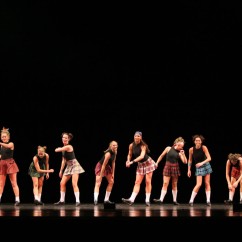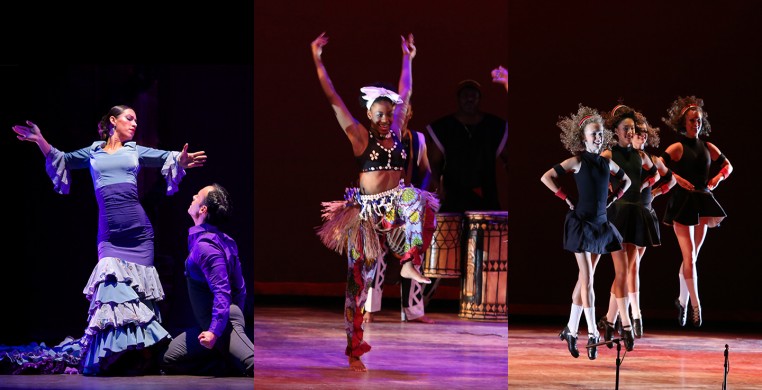The rockin’ stompin’ syncopated beat of the Chicago Rhythm Fest audience, clapping hands, stomping feet, and chanting “Weee--got Rhy--thm!” literally shook the rafters of the Auditorium Theatre last Saturday night for the culmination of the Chicago Human Rhythm Project’s “Stomping Grounds.”
The entr’acte, orchestrated by CHRP artistic director and quintessential Master of Ceremonies Lane Alexander, was emblematic of his mission to bring diverse audiences together under one roof to experience the cultural richness of Chicago’s neighborhoods, as represented by five outstanding, culturally-specific exemplars of “percussive dance.”
And what, exactly is “percussive dance,” you may ask. If you’re the Trinity Irish Dance Company, Ensemble Español Spanish Dance Theater, the Mexican Folkloric Dance Company, Muntu Dance Theatre of Chicago, or BAM!, it’s making a joyful noise with your bare feet, tap shoes, Flamenco boots, jig shoes, and every other body part that can clap, snap, slap, or pop in audible rhythm. Oh, and this can include voice and musical instruments as well.
Presented as part of Roosevelt University’s Auditorium Theatre series, “Made In Chicago,” the one-night-only Rhythm Fest drew a perfect melting pot of all ages to the celebration of Chicago’s cultural heritage. And you didn’t have to be of Irish, Mexican, African American, Spanish, or Yankee extraction to join in the enthusiasm, cheers and whoops floating freely from the packed house toward the Auditorium stage.
“Rhythm Fest’s” success is due in large part to Alexander’s careful, long-range planning and his determined vision to promote culturally-specific percussive dance as a vehicle for community-building and breaking down barriers that isolate neighborhoods from each other, thereby “fostering social reconciliation through the universal language of rhythm.”
For the past two months, CHRP’s “Stomping Grounds” has hosted six free, neighborhood performances, in partnership with DuSable Museum of African American History, the National Museum of Mexican Art, Northeastern Illinois University, Garfield Park Conservatory, The Irish American Heritage Center, and the Chicago Cultural Center. In addition, this year, Stomping Grounds expanded to include an educational component, delivering lecture/demonstrations, master classes, and teacher trainings at sixteen Chicago Public Schools in close proximity to the neighborhood performances. Rhythm Fest’s entr’acte audience participation experience was an example of one of the interactive activities Stomping Grounds used to engage their school audiences in the idea of rhythm-making as universally accessible across cultural barriers. And wow, is it ever!
The well-paced program showcased the five distinguished Chicago companies, each unique in its own way. Uniquely different as each was, a thread of commonality wove across the evening. While the rhythms of Irish dance in Mark Howard’s “Johnny” (1991) conformed to the specific cadence, energy, and lilt of Mark Kirkpatrick’s original Irish music, many of the heel digs, beats, ball-changes, shuffles, knee flexing, and general foot magic echoed in BAM!’s “Anthology of Jazz-Part 1 Opus 1 (1943), choreographed by American tap legend, Harold “Stumpy” Cromer, and performed here by CHRP’s resident tap dance company. The collision of Irish and African cultures in 19th-century America gave birth to Cromer’s clapping, hand-shimmying, pirouettes and sissones, reminiscent of Muntu’s earthy attack and Trinity’s elfin sprightliness, springing onto the stage like a battalion of leprechauns.
Muntu Dance Theatre’s powerhouse drum orchestra in Moustapha Bangoura’s “Sorsornet,” whose origin derives from Guinea, West Africa, and the Boke region, ignited an irresistible fire in the bellies of audience and dancers alike, setting the performers’ feet in a patter of micro-vibrations below while arms swung arcs of rhythmic freedom above, and controlled torso isolations syncopated in the middle. Later on in the program, Ensemble Español’s core of Flamenco cajon percussionists had a similarly visceral effect with their 12-count rhythms and tonal modulations.
Mexican Folkloric Dance Company’s colorful costumes in both “Tablado Jarocho” and “Quadro Tapatio” served dual function as both movement partners and beautiful visual spectacle. The women’s lacy dresses in the first piece fanned and twirled in flirtatious waves, revealing the rhythmic propulsion of their feet. The men’s huge sombreros in the second provided the impetus for swirls and flourishes, curving torsos, and intricate heel-stomping, filling the stage with kaleidoscopic patterns of large-group formations and partnering. Mexican Folkloric Dance Company
Mexican Folkloric Dance Company
Ensemble Español’s Flamenco musicians, especially heart-wrenchingly poignant singer Patricia Ortega, performing live on stage, formed an integral part of Irma Suárez Ruiz’s mesmerizing solo, “Duende Gitana.” Her wrists and hands spoke articulate volumes, the voice of her soul, each finger a seemingly separate organism of expression, while footwork intensified as the drum beat accelerated in speed and momentum.
BAM!’s Act Two “Anthology of Jazz-Part 2," featuring Martin Bronson’s “A Night In Tunisia” (2015) to the music of Dizzy Gillespie, showcased the tap ensemble at what it does best, integrating the essence of jazz musical structure into the body and spatial design of dance. It doesn’t hurt that these tappers have virtuoso chops, and each one took his or her dazzling turn in a riff that corresponded to one of the musical instruments. Alexander’s “In Walked Bud” (2016) to the music of Thelonious Monk further showcased the company’s clean attack and breezy touch in their tapping interchange with scat singing and the impressive extended unison finale of the piece. BAM!
BAM!
Closing the program on a high note, Trinity Irish Dance Company performed “Curran Event” (2000), an unaccompanied departure from strictly traditional Irish dance forms, choreographed by Sean Curran in collaboration with the dancers.  Trinity Irish Dnce Company
Using full-body movement, with free-wheeling arms and a healthy dose of ‘tude in head and shoulder gestures, it played cross-over cultures with hip-hop and pop idioms sidling up to the more classic Irish steps. A semi-crazed paddy-cake interlude and the generally over-the-top human exuberance of street dancing elicited a few unsolicited, “Wuz UP”s, “Right On!” and “Go Mama!” from the enthusiastic audience, proof positive that Rhythm Fest was much more than great entertainment.
Trinity Irish Dnce Company
Using full-body movement, with free-wheeling arms and a healthy dose of ‘tude in head and shoulder gestures, it played cross-over cultures with hip-hop and pop idioms sidling up to the more classic Irish steps. A semi-crazed paddy-cake interlude and the generally over-the-top human exuberance of street dancing elicited a few unsolicited, “Wuz UP”s, “Right On!” and “Go Mama!” from the enthusiastic audience, proof positive that Rhythm Fest was much more than great entertainment.

